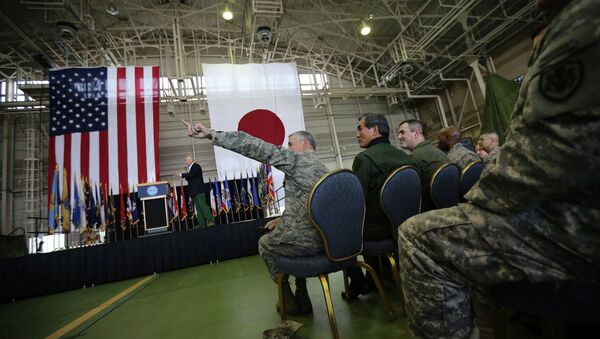WASHINGTON, November 15 (Sputnik) — America’s “pivot to Asia” is not limited to an attempt to consolidate trade partners — it also includes a return to an American military presence in the Pacific, a move meant to limit and confront China and Russia.
The three main partners of America’s military alliance in Asia are Australia, Japan, and South Korea, all of which have the status of Major Non-NATO Ally. Japan currently hosts almost 50,000 US troops, and another 28,500 are stationed at 36 installations across South Korea.
The goals of these forces becomes clear when their recent actions are considered together.
In April 2014, an American spy plane was intercepted by a Russian jet over the Sea of Okhotsk. In May 2014, two Global Hawk drones were moved from Guam to Japan with the express purpose of spying on Chinese and North Korean military positions.
Also in May 2014, Japan signed a cooperation accord with NATO to enhance integration on a variety of issues, including missile defense and presence in Central Asia. This agreement laid the groundwork for a “joint anti-piracy drill” in the Gulf of Aden in September, and Exercise Keen Sword, which began on November 11, and will allow 11,000 US troops to “practice and coordinate procedures and interoperability in all warfare disciplines.”
Leading Japan’s military resurgence is Prime Minister Shinzo Abe, who, according to the New York Times, has “increased military spending for the first time in a decade, and loosened self-imposed restrictions on exporting weapons.” The Times also notes that “Washington has generally been keen for Japan to take on a more active military presence in the region to counterbalance China’s growing might.”
To understand Abe’s aggressive militarism, as seen by his desire to rewrite the Japanese constitution to allow the Japanese military to take a more aggressive role — a move rejected by voters, and his visit to the Yasukuni shrine honoring Nazi war criminals, it is helpful to explore the history of his grandfather, Nobusuke Kishi.
After World War II, the American policy in Japan was similar its policy in Europe — establish a permanent presence and realign with defeated axis enemies to battle the Soviet Union. In Japan, that meant rehabilitating war criminal Nobusuke Kishi, who had played a role in the economic expansion and exploitation of Japan into Manchuria, and rose to Minister of Munitions in the Japanese government that declared war on the Allied powers.
Throughout the 1950s, when the Americans were placing puppet governments throughout Southeast Asia, Kishi was one piece in that game. Thanks to his close friendship with American business interests, Kishi received American support as early as 1954 while he was rebuilding the conservative Liberal Party (which later merged with the Democratic Party), and around $10 million a year between 1958 and 1960.
Kishi was also given control of the powerful post-war reconstruction M-Fund, which he used to enrich himself. The M-Fund was originally set up by American General William Marquat, chief of the Supreme Commander of Allied Power’s Economic and Scientific Section, to rebuild the Japanese economy, but quickly turned into a way to embezzle the gold stolen by Japanese Nazi’s during the war into far-right campaigns and mafia activities.
In return for this investment, Kishi helped turn Japan into an American military base for their operations in Vietnam. Now, sixty-five years later, his grandson is allowing America to continue their occupation of Okinawa and attempting to line up whatever parts of the Japanese military he is legally allowed to commit to support the American military buildup against China.
For its part, South Korea’s close military relationship to America has existed since the World War II partition agreement with the Soviet Union. After the Korean War ended, Americans drew down their troops, but never fully ended their occupation, and thanks to an October, 2014, agreement between the respective Defense Ministers, Americans will exercise “Operational Control” of the 500,000 Korean forces if any hostilities break out with North Korea.
South Korea has also moved closer to NATO thanks to Deputy Secretary-General of NATO, Alexander Vershbow, who served as Ambassador to the Republic of Korea in 2005-2008. During his tenure, he helped expand the American military base at Pyeongtaek, Camp Humphries, into the largest Army garrison in Asia.
In his current role at NATO, Vershbow visited South Korea on October 27, 2014, to speak at the Northeast Asia Peace and Cooperation Initiative Forum. He praised Korea for “contribut[ing] troops to the NATO-led mission in Afghanistan; lead[ing] one of the most effective Provincial Reconstruction teams in Parwan, and running an important medical hospital,” and “pledg[ing] aid towards both the sustainment of the Afghan National Security Forces and Afghanistan’s future economic development.”
In addition to the NATO involvement, 200,000 South Korean troops drilled with 12,700 American troops from February to April as part of the “Foal Eagle” and “Key Resolve” exercises.
No one doubts the importance of the economic ties and open markets between the United States and Asian nations. However, when military ties are used to aggressively push American troops to China and Russia’s borders, and trade deals are used to exploit the sick and push an environmental agenda that puts the profits of polluting industries ahead of the health of the masses, tensions in the area will only increase, and instability and unrest will follow.

